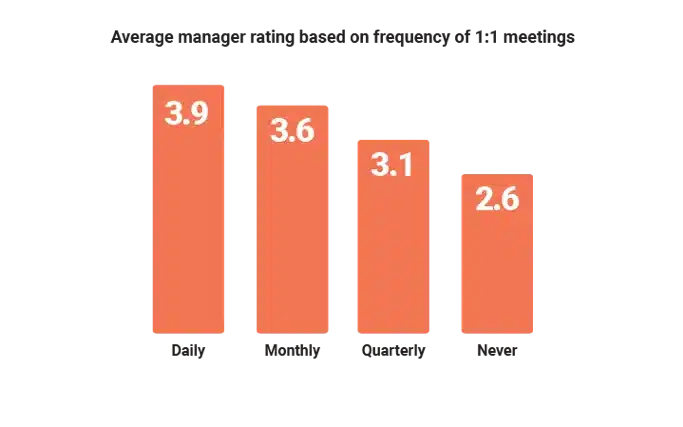Meet John. John is a manager in an ad agency. He has a team of 8 direct reports, who come with an exceptional experience on their resumes.
Unfortunately, the team tops the list of underperformers in the organization. This is a matter of concern for John, and the organization as well.
What could be the possible reason? Is the organization not good? Or should John take the blame?
John’s manager Ruth decides to meet John to discuss the matter and figures out multiple reasons for the exceptional team’s unexceptional performance – lack of their trust in John, no role clarity, expectation mismatch, no clear vision of goals, no guidance to overcome challenges, being just a few.
Ruth gives just one piece of advice to John and asks him to religiously follow for a month. After a month, results begin to improve.
What was the secret Ruth told John that helped him turn his team’s productivity from worse to good in just a month?
Intrigued?
She advised him to use a manager’s most effective and efficient tool: One on One meetings.
Elizabeth Grace Saunders, the author of ‘How to Invest Your Time Like Money’, and the founder of Real Life E Time Coaching & Training, says,
One on ones are one of the most important productivity tools you have as a manager. They are where you can ask strategic questions such as, are we focused on the right things? And from a rapport point of view, they are how you show employees that you value them and care about them.
Whether you are a new manager like John or a seasoned one like Ruth, whether you are new to having one on ones or have them regularly with your direct reports, this simple and easy to implement guide will help you to use a manager’s most efficient tool – one on one meetings – in the best way possible to build high performing teams.
How is a one on one meeting different from any other meeting?
Many confuse every face-to-face meeting between a manager and employee with a one on one meeting. But that is not true (more on this in ‘busting the myths around one on ones sections).
In simpler words, a one on one meeting is a recurring, open-ended, two-way interaction between a manager and her direct reports, where direct reports are free to speak their minds and open their heart with their manager.
The fundamental purpose of a one on one meeting is to help the manager connect with her team, understand and remove any blockers they might be facing, and keep the feedback engine running.
This ensures that every member in the team gives their personal best to progress, grow and achieve great results.
Why is a one on one a manager’s most effective tool?

Why do we say that one on one is a manager’s most effective tool to build a highly engaged and productive team?
Let’s try to answer this question by first understanding what managers want to achieve to become great from good.
To be a great manager, you need to be a people’s & result-oriented person – implying you truly care for your team and at the same time are always in the quest for progressing to achieve best results.
But how do you ensure your team feels they are valued and cared for, so that they are always striving to give their best to produce the greatest results?
While there are many other routes like leadership training, seminars, learning from peers, to help you manage your team, nothing works as effectively as regular and high-quality one on one meetings with your direct reports.
Andy Grove, former CEO & co-founder of Intel, in his book ‘High Output Management’, says,
Ninety minutes of your time can enhance the quality of your subordinate’s work for two weeks, or for some eighty-plus hours.
Based on our interactions and learnings while working with a number of managers, we have summarized five main benefits of effective one on one meetings with your employees.
1 Consistent & regular feedback
Feedback is an essential component of your progress as a manager and helps you track the progress of your team.
An article in Forbes highlighted that 65% of employees want more feedback on their work than they receive today.
Talking of today’s workforce, millennials crave for ongoing and regular feedback from their managers.
A survey conducted by Clutch found that ‘of the millennials whose managers do provide accurate and consistent feedback, 72% find their job fulfilling’.
The key is consistency and accuracy while giving feedback. And this can be achieved through regular 1-on-1 meetings with your employees.

Since a 1-on-1 is a recurring event in the calendar of a manager and her direct report, it provides the manager a unique opportunity of sharing regular and real-time feedback.
This in turn helps the direct report implement the feedback into the work immediately and correct the errors before they become irreversible mistakes.
Feedback is not meant to be given to employees only.
If you want to grow as a manager and become a leader, you must welcome feedback from your employees as well.
Your employees work with you closely, and will certainly have important insights on your managerial style, certain decisions concerning them or team, office culture, organization, etc..
What could be a better way to understand your employees’ point of view than a 1-1 meeting?
Employees are often intimidated by their managers and may shy away from giving constructive feedback.
A regular one on one meeting helps your employees understand your temperament making it easy for them to be candid with you.
2 Cement your relationship with your team

Kim Scott in her book ‘Radical Candor’ talks a great deal about ‘Caring personally’ for your team.
‘Caring Personally’ means demonstrating that you “give a damn” about the people you work with.
A 1:1 meeting is the best way to show your team you care for them and value their efforts. Your team knows how busy you are as a manager. You not only take care of your team but also have a bunch of your own deliverables to take care of.
When you religiously take out time for your employees from your busy schedule, it makes them feel valued.
You can sense an influx of positive vibes into the team after every 1:1 that you conduct.
A 1-on-1 provides you the launchpad to build a relationship of mutual trust and respect with your direct reports, and then cement it with every 1-on-1 to follow.
3 Nip the problems right in the bud
Imagine that you have a new direct report in your team of 12.
You are sure she has great potential and give her a month’s time to settle in the role. When you review her performance after a month, you are dissatisfied.
Thinking ‘it’s been only a month’, you decide to give her some more time to settle.
You never have 1-on-1 with her and assume she would come up to you on her own to discuss any challenge(s) she might be facing.
Three months down the line, her performance remains below the mark and she finally quits in the fourth month.
The true reason for her resignation will always remain a mystery to you since you never had a 1-on-1 meeting with her to understand her roadblocks and provide her a comfortable environment to grow fearlessly.
A one on-one is a perfect opportunity for you to personally understand the real challenges your employee might be facing and remove the roadblock(s) in a way that is best suited for that employee.
Andy Grove in his book High Output Management writes:
A common rule we should always try to heed is to detect and fix any problem at the lowest-value stage possible.
This in turn helps a manager nip the problem right in the bud, before it becomes too big to tackle, and lead to something as extreme as a bright and high potential employee leaving the team.
4 Check Motivation level / morale

A manager is only as good as her team.
And if you want your team to keep giving their best, you certainly would want them to be motivated and driven.
Imagine you have an employee Jake working with you for more than 2 years now.
He is exceptional in his work, usually, but now you sense a sudden drop in his performance. His reports are not elaborate and he starts making careless errors.
Knowing that Jake is a star-performer, you are sure something is bothering him. His motivation level is at a new low.
So, how would you spot the real issue? Ideally, you would call a meeting with him, understand the problem and try to provide him a solution.
Was there a way to foresee the drop in Jake’s motivation level? Yes.
If you were conducting regular 1-on-1 meetings with Jake, you could have kept a tab on his motivation level and solved the problem before it grew bigger and started affecting his output and team results.
Building a high motivated team is not a one-day job. You have to work towards it constantly by interacting with your employees at regular intervals and checking with them on their motivation levels.
Through a 1-1 meeting you can understand how motivated your team is, encourage them if the motivation level is high, and remove the roadblocks if it is low.
5 Coach the team
Out of the 8 qualities of a good manager summarized by Google, a very important one is ‘Be a coach’.
One of the traits of a great coach as defined by Google is:
Tailoring approaches to meet individual communication styles in regular one on one meetings
A manager cannot succeed with the one-shoe-fits-all approach. No two employees are the same. Each employee comes with a unique set of strengths & weaknesses, working style, and communication style.
One employee’s strength might be another employee’s weakness. And hence, you cannot provide the same appreciation or solutions to all employees.
You will have to customize your interactions with each employee based on what works the best for them. And you can achieve this only through regular one on one meetings with your employees.
One on one meeting is your golden chance to understand what works best for each of your employees and provide tailored solutions to them for their unique problems.
OKR Software – Used by 500+ Companies
Transform your managers into leaders through personalized coaching, bite-size learnings and make it super easy for them to have meaningful 1:1s, check-ins, and align goals(OKRs).
Try One-on-Ones tool for Free
Build and track your one-on-one culture and make sure that every one-on-one is actionable and meaningful.
Busting the myths around one on one meetings
Now that we have established that one on one meetings are essential for your team to grow, let us address the myths that surround them.
Many believe 1:1 meetings to be regular catch up meetings, stand-ups, or like we talked earlier, a face-to-face meetings where you discuss issues like performance review.
Some also think one on one meeting should only be held in closed doors, or experienced team mates don’t need a 1-1 meeting.
These are, however, only misconceptions. Let us address the most common myths here before we proceed to discussing the ingredients for a successful 1-on-1 meeting.
1 It is just another meeting
One on one is not ‘just another meeting’. It is a meeting which your direct report looks to forward to more than you do.

As Ben Horowitz says,
The key to a good one on one meeting is the understanding that it is the employee’s meeting rather than the manager’s meeting.
An important part of being a good manager is via effective communication, and you can only do that if you listen to your employees.
2 I have a team of experienced employees, they don’t need a one on one!
Well, that is really not true!
No matter how much experience your team has on their resume, they will always need a one on one to exchange feedback.
Senior employees also tend to feel lost if not given timely feedback. And, given their experience it becomes all the more important to keep them engaged.
You can achieve both through a 1-1 meeting.
3 I have an open door policy, why do I need a one on one meeting?
Most managers tell their employees about the ‘open door policy’ and expect that if the team faces any issue they would certainly knock the door, or in simpler words, walk right up to you and discuss the issue.
But just try to rewind and think, how many times has an employee really walked up to you and talked about the challenges she is facing at work?
An open-door policy lacks the personal touch and doesn’t give you the opportunity to personally address the issue your team might be facing.
Your employee may not walk up to you for reasons like they are shy, or don’t know when is the right time to speak with you, or if you would be tolerant about the issue they might raise.
More often than not, employees would struggle with issues, and may even get frustrated, eventually leading them to move out. You certainly don’t want that to happen.
4 I can give feedback in a performance review meeting as well. Why one on one then?

A performance review meeting is a quarterly, or bi-annual or annual conversation between you and your direct report.
Performance review meetings are more about evaluating the performance of the employee over a stipulated period of time.
By the time you have this meeting, results have either been achieved or targets have been missed, and it would be too late to provide constructive feedback.
Feedback is not one-time but a continuous process. You need to provide feedback and at the same time accept it with grace from your employees.
In a performance review meeting you can only share your opinion with the direct report which may or may not be receive
d well by him.
Also, the direct report will not get much of an opportunity to share their mind honestly.
5 I don’t have anything new to talk about one on one every week!
Most managers end up asking the same questions in every one on one.
They either run out of ideas or don’t know how to channel the conversation in a way that new points are discussed in the meeting.
Some commonly asked questions are ‘how’s it going’, ‘how’s work coming along’, etc., but these are only good for starters.
If you want to have a quality 1-1 meeting you must focus on a variety of questions covering areas like recognition, job performance, team dynamics, motivation levels, etc.
For more such ideas you can refer to this comprehensive list of 500+ one on one meeting questions.
6 I only need to listen in the meeting.
While listening constitutes a very big part of holding an effective 1-on-1 meeting, it certainly doesn’t imply that you are only supposed to listen and not say anything.
1-1 meeting is a safe space for your direct report to speak their mind and share their heart.
This, however, should not stop you from providing guidance and coaching your direct reports. Especially, when 1-1 is your only opportunity to coach your employees and take a step closer to becoming a great manager.
OKR Software – Used by 500+ Companies
Transform your managers into leaders through personalized coaching, bite-size learnings and make it super easy for them to have meaningful 1:1s, check-ins, and align goals(OKRs).
Try One-on-Ones tool for Free
Build and track your one-on-one culture and make sure that every one-on-one is actionable and meaningful.
7 It’s okay for me to not take notes.
A common notion is that managers do not have the time to take notes and expect their direct reports to do so instead.

Our interactions with many managers and employees tell us that this is a very big mistake which can result in affecting your team negatively.
Taking notes is not only important for the employee but you, as a manager as well, since this is the first step towards tracking the discussion points and taking action.
8 It’s a waste of time. Cancelling it won’t impact otherwise.
We cannot iterate anymore that a 1-on-1 is not a waste of time. It is instead the best possible way to utilize your work hours to understand your team better.
If you think that cancelling a 1-1 meeting doesn’t have a negative impact, think again.
Cancelling or postponing this crucial meeting, which your direct report may have been looking forward to, will lead to her not taking you seriously and you will also lose the window to unlayer the real cause of your employees dissent for the week gone by.
9 Closed rooms are so boring for a one on one meeting, but that’s the format!
Ben Horowitz in his blog on one on one says,
This is the free-form meeting for all the pressing issues, brilliant ideas and chronic frustrations that do not fit neatly into status reports, email and other less personal and intimate mechanisms.
The interesting thing about this meeting is that it has no set format, and is a free-form of meeting.

If you are wondering where should you have your one on one meeting with your direct report, we recommend not confining yourself to the four walls of your meeting room or conference room, or even your office.
The best part about 1-1 meeting is that you can have it while walking down the corridor, in a coffee shop or in your office cafeteria!
10 I can have a one on one once every two months. That should be enough!
A few managers who we spoke to pointed out that weekly one on one meetings are way too much and so they would rather have them once in a month or maybe two months.
Our advice here is simple and straight!
Any meeting that you call one on one, and are holding it after such long durations, is not a 1-on-1!
A week is a long time for developments to take place. And hence an ideal scenario is a weekly one-on-one, but nothing less than a bi-weekly would do if you want to get the most out of this meeting.
During a Live video streamed by Mark Zuckerberg, Facebook CEO, shared his secret to building and maintaining relationship at work:
We’ve had this tradition, in the last eight years or so that we’ve worked together, where every week we start the week and end the week just meeting one-on-one together, and going over everything that’s going on, and reflect on what’s going on, giving each other feedback.
Step-by-step guide to an effective one on one meeting
A manager is not really a manager without her team. Her team’s success defines her success as a manager. And one-on-one meetings are vital for your team’s success.
According to Gallup, “employees whose managers hold regular meetings with them are almost 3 times as likely to be engaged as employees whose managers do not hold regular meetings with them”.

All successful leaders we look up to today, be it Andy Grove, Steve Jobs, Kim Scott, Jason Lemkin, or Ben Horowitz, emphasize on the importance of 1-on-1s.
In fact, Ben Horowitz in his book ‘The Hard Thing about Hard Things’ recalls an incident where he was willing to fire a senior leader who was not having regular 1:1s!
But what really goes into ensuring you are having the 1-1 meeting in the most effective way to get the most out of it?
Having regular one-on-ones is not enough. You must ensure you are avoiding the most common one-on-one meeting mistakes.
Here’s a step-by-step guide to help you make the one-on-ones productive, effective and your most powerful tool.
1 Set the schedule

The first and foremost step towards having an effective 1 on 1 meeting is by scheduling a recurring meeting with each of your direct reports and following it religiously. A one on one meeting is not an ad-hoc meeting.
You cannot have a selective approach towards 1-on-1 meetings. You need to have these meetings with all your direct reports, implying you will need to take out time for each of them.
Frequency and duration are two main points you need to factor in before committing yourself to the meeting schedule:
– Frequency:
While an ideal frequency of a 1-on-1 meeting is once every week, factors like team size and traveling often, have to be taken into account before committing yourself to a schedule with your direct report.
If you are managing a team of five, once a week frequency is doable, but if it is bigger than that you can have a bi-weekly meeting.
Jason Lemkin, Founder of SaaStr, says,
… you have to find a way to do 1-on-1 meetings with all your direct reports. At least every two weeks.
Andy Grove, however, has an interesting take on the frequency of one on one and we agree with him.
He believes that the frequency should not be decided by your time but by how much of your time an employee requires to give his best, as one-shoe-fits-all approach doesn’t work for a manager, and she has to adapt according to each of her employees’ experience, aptitude, at
titude, and working style.
Accordingly, you should have one on ones frequently (for example, once a week) with a subordinate who is inexperienced in a specific situation and less frequently (perhaps once every few weeks) with an experienced veteran.
The Predictive Index’s people management report 2019 found that ‘manager ratings jump from 3.1 to 3.6 when managers meet with their direct reports monthly vs. quarterly.

– Duration
The duration of your 1-1 should not be less than 30-minutes and can go up to 1 hour. You need not schedule all your 1-1s on a single day.
Let’s say you have 40 working hours, and are leading a team of 8 people. It is not a big ask to spend 4-8 hours understanding your employees!
Kim Scott in her book ‘Radical Candor’ while talking about one on one meeting says:
I like to meet with each person who works directly for me for fifty minutes a week. But I can’t bear more than about five hours of time in my calendar… If you have ten direct reports, I’d shift it to twenty-five minutes a week.
2 Stick to it
A very important step to follow-up the first step of scheduling the meeting is to stick to the schedule.
Stick to the schedule and try your best to show up at every 1 on 1 meeting. We understand that not all days would be the same. On certain days you may be travelling, or may fall sick, or might be away on a vacation.
Barring such exceptions, you should always be there for the one on one; and on time. Not showing up, cancelling or postponing, sends the message that this is just another meeting for you, whereas your direct report might just have been waiting for the meeting to discuss the underlying issue(s) bothering her.
Living up to the scheduled one on one meeting and commit to it with utmost sincerity, showing up on time, will help you earn the respect of your team and also send the message that you care.
3 Set agendas

This holds true for every meeting, and one on one is no different.
Starting a meeting on a vague note, especially when you are having a busy day will only lead to wasting your and your employee’s time.
To set an agenda send across a few questions to your employees, such as, ‘how motivated are you’, the answers to which will help you build your talking points for the meeting.
More than having your agenda clear, it is important to give the freedom to the employees to be able to set their agenda or talking points as well.
They may be facing problems in their current project, or they may be facing an issue while working with a team member, or they might be facing the challenge of not being able to prioritize work properly.
Stressing on the importance of letting the employees set their agenda for the meeting, Andy Grove in High Output Management says,
The most important criterion governing matters to be talked about is that they be issues that preoccupy and nag the sub-ordinate.
To help your employees set agenda, let them know how you want the agenda to be shared. You can do this through warmup questions, or ask them to jot down the points in a shared document.
Some managers believe in free-flowing meetings with no structure or set agenda. While this may work for smaller teams, it can lead to a no-result or inconclusive meeting in a setup where you have more than five direct reports.
4 Listen

Once you have an agenda set and you are sharing the space with your direct report for the scheduled 1 on 1 meeting, make sure you take care of the most important prerequisite: Listening.
Kim Scott says,
1:1s are your must-do meetings, your single best opportunity to listen, really listen, to the people on your team to make sure you understand their perspective on what’s working and what’s not working.
She further says that, ‘the purpose of a 1:1 meeting is to listen and clarify – to understand what direction each person working for you wants you to head in, and what is blocking them.
Listening is a very important part of effective communication. If you don’t listen to your employees, they would not feel heard and valued.
Remember what Steve Jobs once said: ‘We hire people to tell us what to do, and not the other way round’.
5 Ask questions & encourage feedback

Once you have heard your direct report, it is your turn to dive deeper.
One of the most common mistakes that managers make during a 1 on 1 meeting is to limit the questions to checking the status.
Go beyond the regular status update questions, which include, ‘how is the project coming along’, ‘what are you working on this week’, ‘how was your last week’, etc.. Like we said earlier, 1-1 is not a status update meeting.
If you need to ask about the project, you can keep a separate meeting for that, but that won’t be called a one-on-one.
Never forget that this is your opportunity to go beyond the regular, dig deeper to understand your employee better, and provide them the career development they are looking for.
You must include one on one meeting questions from different areas of work and/or life, for instance, team dynamics, work recognition, goal setting, job performance, feedback about you and the company.
Good questions during a one on one can have a massive positive impact on the quality of the meeting.
And don’t forget that getting feedback from your employees constitutes an important objective of a 1-1 meeting. To drive a healthy exchange of feedback, ask questions like:
- Are you happy with the amount of feedback we give to each other in the team?
- Would you like to receive more feedback from me and the team?
- Do you find my feedback specific and actionable?
- Do you have any constructive criticism for me?
Feedback is a continuous and two-way process, and it is important to ask yourself if your feedback is helping your team.
OKR Software – Used by 500+ Companies
Transform your managers into leaders through personalized coaching, bite-size learnings and make it super easy for them to have meaningful 1:1s, check-ins, and align goals(OKRs).
Try One-on-Ones tool for Free
Build and track your one-on-one culture and make sure that every one-on-one is actionable and meaningful.
6 Take notes

We talked about how managers think they do not need to take notes during the 1 on 1 meeting, and busted the myth.
Most managers make the mistake of believing that taking notes is a waste of time, or it is the duty of their direct reports to do so.
Imagine a scenario where you are having 5 one on ones with all five of your direct reports on 5 different days of the week for a duration of 1 hour each.
Your team has been working on a major project that is crucial to the company’s success and they all have been facing different issues and challenges.
You, however,
choose not to take notes and expect your direct reports to do so instead, which they do and share with you as well.
When you decide to look at the notes they sent to you, you cannot draw much meaning out of it as it was their interpretation of the situation and you call them again to discuss the problems.
The chaos leads to a delay in the delivery of the project, reflecting really bad on your team, and eventually, you.
This situation could have been easily avoided if you had taken notes, with the intention to act upon it.
A very big advantage of you taking your own notes during the one on one meeting is that your employees feel assured they are being heard and their words are important.
To effectively track action items, you need to create a seamless system. As Andy Grove puts it:
When [the direct-report] takes a note immediately following the supervisor’s suggestion, the act implies a commitment, like a handshake, that something will be done. The supervisor, also having taken notes, can then follow up at the next one-on-one.
Taking notes is the best way to start working on a system of accountability, but they are meaningless if not followed-up with actions.
7 Drive real actions by tracking action items
Peter Drucker, Leadership Expert & author, says:
Unless commitment is made, there are only promises and hopes… but no plans
A manager can show she is true to her word only by tracking action items and following them up with real actions.
When you take action on the items discussed, you are building an environment of trust and accountability in your team. It implies that your connection with your team will grow stronger and they will respect you even more.
However, lack of action can dissolve the very purpose of having the one-on-one meeting, portray you in a very bad light, lower your respect and create an atmosphere of distrust in your team.
The success of a 1-on-1 meeting can be judged by the actions taken based on the discussion in the meeting.
According to a study, ineffective and unproductive meetings cost United States businesses $37 billion every year!
An ineffective and unproductive meeting is the one where the attendees leave without any takeaways and action items to track or follow-up on.
Paul Axtell, a corporate trainer and author of award-winning book ‘Meetings Matter’ writes in a Harvard Business Review article:
Getting firm, clear commitments is the primary way to ensure progress between meetings. In order for a conversation to lead to action, specific commitments must be made. Progress depends on clearly stating what you will do by when and asking others to do the same.
To make the most out of your one on one meetings, we recommend using a one on one meeting software that allows you to do all of the above at one place.
8 Follow-up
When the meeting ends, and you and your direct report walks out with notes and action items listed down, make sure they are assigned to the respective owner of the task and you regularly follow-up on the progress of the action item.
Progress can only be measured by actions taken. And, so it is important to follow-up and understand if your team is facing any blockers in implementing the points discussed.
Conclusion:
The fundamental truth about 1:1 meetings is that they are about your employees, and not you. And, no matter how busy your day might be, you ought to take out time for meeting your direct reports in a 1:1 meeting, and conclude it with a trackable list of action items to follow-up on.
PS: You can check out how to build a one-on-one culture in the company through your HR.







